
Volume:12Issue:01|Jan2025 www.irjet.net
International Research Journal of Engineering and Technology (IRJET) e-ISSN:2395-0056 p-ISSN:2395-0072


Volume:12Issue:01|Jan2025 www.irjet.net
International Research Journal of Engineering and Technology (IRJET) e-ISSN:2395-0056 p-ISSN:2395-0072
Harish Patil1 , Hrishikesh Taware2 , Priya Bhadekar3 , Onkar Lonsane4
1Student of Dept. of IT, BE, PCET’s NMIET, Maharashtra, India
2Student of Dept. of CS, BE, PCET’s NMIET, Maharashtra, India
3Student of Dept. of CS, BE, PCET’s NMIET, Maharashtra, India
4Student of Dept. of CS, BE, PCET’s NMIET, Maharashtra, India
Abstract - In the rapidly evolving landscape of education and employment, personalized and dynamic career guidance platforms are essential to bridge the skill gap and enhance employability. This paper introduces an AIPowered Personalized Learning and Career Development Platform, EduWay - Integrated Learning and Career Pathway Platform, designed to create tailored learning paths and provide job recommendations based on userspecific data collected through an interactive survey at registration. By analyzing personal, educational, and professional backgrounds alongside career aspirations, the platform generates customized roadmaps, empowering userstoachievetheirgoalsefficiently.
The platform leverages cutting-edge technologies, including React for an intuitive user interface, Spring Boot for robust backend functionality, and AI/ML algorithms for intelligent content recommendations and job matching. Gamification elements such as badges, leaderboards, and progress dashboards ensure user engagement and motivation throughout the learning journey. The system also fosters community collaboration through group discussions, and teamchallenges.
This paper discusses the conceptual framework, implementation details, and future scope, including adaptive AI-driven learning by providing AI Agents and advanced job market analytics. By targeting both academic excellence and practical industry alignment, the platform aims to redefine personalized education and job readiness, positioningitselfasacompetitivetool.
Key Words: AI-Powered, Personalized Learning, Career Development, Job Recommendations, AI/ML Algorithms,Gamification,Badges,UserEngagement.
Inaneraofrapidtechnologicaladvancementsandshifting job market demands, individuals at various stages of educationorprofessionallifefacesignificantchallengesin navigating their career paths. From students making critical decisions after 10th or 12th grade to undergraduates unclear about their direction, or professionalsseekingtoadvanceorpivottheircareers,the needforstepwisecareerandskillmappingisuniversal.
Traditionalcareercounselingandeducationsystemsoften fallshortinaddressingthesediverseneedsduetoalackof mentorship, inadequate resources, or insufficient knowledgeofin-demandskills.Thisgapleadstountapped potential, mismatched training efforts, and ill-equipped candidatesenteringthejobmarket.
To address these challenges, we propose EduWayIntegrated Learning and Career Pathway Platform, an AI-driven solution that offers personalized learning paths using AI Agents, gamified engagement, and career recommendations. The platform utilizes a detailed, interactive survey during registration to gather user information such as educational background, career goals, learning preferences, and skills and generates tailoredroadmapsandresourcesuggestions.
EduWay bridges the gap between education and employability by empowering users to make informed decisions and acquire relevant skills and opportunities. Whether guiding high schoolers in choosing the right career, supporting undergraduates in building focused learningplans,orenablingprofessionalstoreskillfornew roles, EduWay aims to be a transformative tool for career success. This paper explores the platform’s conceptual framework, development progress, and its potential to drive academic excellence, workforce readiness, and holisticgrowthforusersateverystage.
Career guidance and skill development are critical yet oftenoverlookedaspectsofanindividual’sjourneytoward personal and professional growth. Students and professionals alike face significant challenges at different stagesoftheirlives:
High School Students (10th/12th Grade): Often lack access to reliable guidance on choosing the right career paths, leading to uncertainty and misinformed decisions duringapivotalstageoftheireducation.
Undergraduate Students: Struggle to align their academic pursuits with industry demands, resulting in unclear goals, inefficient learning paths, and a lack of job readiness.

Volume:12Issue:01|Jan2025 www.irjet.net
International Research Journal of Engineering and Technology (IRJET) e-ISSN:2395-0056 p-ISSN:2395-0072
Professionals Seeking Career Transitions: Find it difficultto reskill orpivotinto newroles,particularlyina fast-evolving job market that demands specialized and dynamicexpertise.
Traditional systems fail to provide tailored support that accounts for individual aspirations, learning preferences, and current capabilities. This results in misaligned career choices, underdeveloped skills, and missed opportunities for growth. Additionally, the absence of a structured, personalized approach to skill development and job readiness exacerbates this problem, leaving individuals unprepared for the workforce and employers unable to findqualifiedcandidates.
There is a pressing need for an innovative platform that bridgesthesegapsbyofferingpersonalizedlearningpaths, actionable career guidance, and targeted job recommendations. Such a solution must cater to the unique needs of users at various stages of their journey, empowering them to make informed decisions, acquire relevantskills,andsucceedintheirchosencareers.
To address the challenges faced by individuals across diverse stages of their career journeys, we propose an EduWay - Integrated Learning and Career Pathway Platform. This platform leverages advanced technologies to provide tailored guidance, skill-building resources, and jobopportunitiesbasedontheuniqueneedsofusers.
Survey-Based User Profiling: At registration, users complete an interactive survey capturing personal background, educational history, career aspirations, and learningpreferences.Thisdatahelpstheplatformcreatea personalizeduserprofile.
AI-DrivenCareerPathRecommendations: Theplatform utilizes AI algorithms to analyze user data and generate career roadmaps tailored to their goals. These roadmaps highlight essential skills, recommend learning resources, andsuggestachievablemilestones.
Custom Learning Paths: Personalized learning paths are designed to address skill gaps and align with the user’s career objectives. Resources include curated courses, tutorials,quizzes,andprojects.
Gamified Learning Experience: Gamification elements such as badges, progress points, and leaderboards incentivize users to engage with learning materials and completemilestones.
Community Engagement Features: Users can connect with mentors, collaborate with peers, and participate in group projects. A built-in mentorship program fosters guidancefromexperiencedprofessionals.
Targeted Job Recommendations: As users progress through their learning paths, the platform provides job recommendations that align with their skills and preferences. It also offers suggestions for additional skills toenhanceemployability.
Flexible Design for All User Levels: The platform is designed to support high school students deciding on career paths, undergraduates refining their goals, and professionals seeking new opportunities or career transitions.
Empower Informed Career Decisions: Enable users to make well-informed career choices by providing personalizedandactionableguidance.
Bridge the Skill Gap: Equip users with the necessary skillsandcertificationstomeetcurrentindustrydemands.
Facilitate Lifelong Learning: Promote continuous learning through adaptive roadmaps and updated resourcestailoredtoevolvingcareergoals.
Enhance Engagement Through Gamification: Increase user motivation and participation by incorporating rewards,challenges,andmilestones.
Build a Collaborative Community: Foster a supportive network where users can learn from mentors, share knowledge,andcollaborateonprojects.
Streamline Job Matching: Connect users with relevant job opportunities based on their skills, progress, and preferences.
Support Diverse User Needs: Design the platform to address the needs of high school students, undergraduates,andworkingprofessionals.
Theproposedplatformintegratesmultiplecomponentsto deliver a seamless and personalized experience for users. The architecture is designed to be scalable, modular, and robust, ensuring that it caters to diverse user needs efficiently.Thesystemcomprisesseverallayers.
The system is an AI-powered learning and career recommendation platform designedtoprovide users with personalized education paths and targeted job opportunities. The website offers a seamless client flow, ensuring a user-friendly experience for learners and job seekers.

Volume:12Issue:01|Jan2025 www.irjet.net
International Research Journal of Engineering and Technology (IRJET) e-ISSN:2395-0056 p-ISSN:2395-0072
User Onboarding: New users sign up and create profiles byprovidingdetailssuchastheirinterests,skilllevels,and careergoals.
Personalized Dashboard: Upon login, users access their dashboard, which displays recommended courses, progress metrics, and gamified elements like quizzes and badges.
LearningPathRecommendation: AIalgorithmscuratea learningpathtailoredtotheuser'spreferences,leveraging pastlearningbehaviorsandinterests.
Progress Tracking: Users track their progress with realtime analytics, including course completion rates, quiz scores,andmilestonesachieved.
Gamified Engagement: The system encourages participation through interactive quizzes, badges, and leaderboardsdisplayedonthedashboard.
Job Marketplace Integration: Users explore job opportunities on a dedicated section of the platform, where AI-powered matching algorithms suggest roles basedontheirskillsandcertifications.
Feedback and Support: A dedicated support section allows users to provide feedback or seek help, ensuring continuousimprovementoftheplatform.
This flow ensures a streamlined, intuitive experience for users, empowering them to achieve their learning and careerobjectivesefficiently.
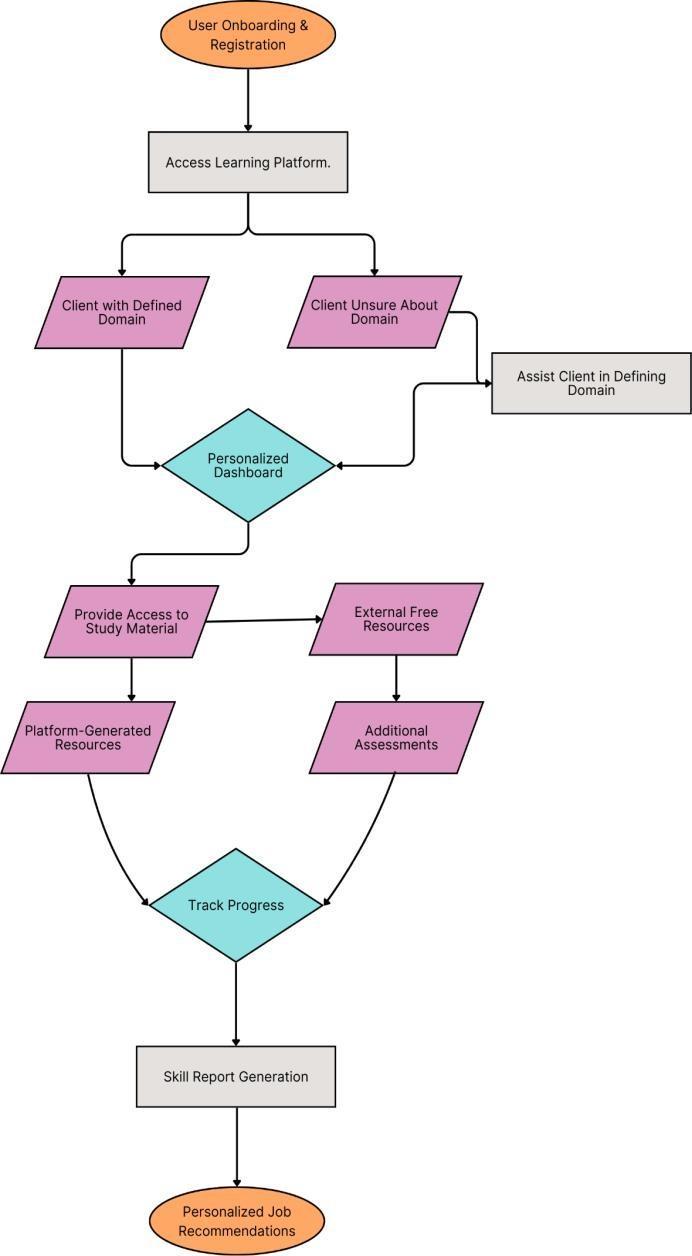
2.3 Technology Stack
1.FrontendStack(UserInterface&InteractionLayer)
The frontend of the application is responsible for delivering an interactive, user-friendly experience for users interacting with learning paths, quizzes, progress dashboards,andcareersuggestions.
React.js: A core JavaScript library for building dynamic andmodularuserinterfaces.
HTML5:Usedforstructuringcontentandwebpages.

Volume:12Issue:01|Jan2025 www.irjet.net
International Research Journal of Engineering and Technology (IRJET) e-ISSN:2395-0056 p-ISSN:2395-0072
CSS3:Employedforstyling,animations,andlayoutdesign.
React Router: Manages navigation between different pagesandviewswithintheapplication.
Axios: A promise-based HTTP client used for making requeststothebackendAPI.
Redux (Optional): A state management library to efficiently manage complex data flows in large-scale applications.
2.BackendStack(BusinessLogic&APILayer)
The backend is responsible for processing business logic, handlingAPIendpoints,andmanagingsecureinteractions betweenthefrontendandthedatabase.
Java: The primary programming language used for backenddevelopment.
Spring Boot: A lightweight framework used for developing microservices, RESTful APIs, and backend systemsefficiently.
Spring Data JPA: Utilized for Object-Relational Mapping (ORM)tofacilitateinteractionwithrelationaldatabases.
RESTful API: Exposes APIs to enable seamless data exchangebetweenthefrontendandbackend.
2.1DatabaseManagement:
MySQL / PostgreSQL: Relational databases used for storingstructureddata.
Hibernate (JPA): ORM framework used for smooth integrationwithrelationaldatabases.
2.2Security:
Spring Security: Handles authentication and authorizationforsecureaccesscontrol.
JWT (JSON Web Tokens): Ensures secure session managementforuserauthentication.
2.3ToolsforTesting:
JUnit:Usedforunittestingbackendservices.
Postman:UtilizedfortestingRESTfulAPIs.
3.AI/MLStack(RecommendationEngineLayer)
The AI/ML stack powers personalized learning paths and job recommendations by processing user data and applyingmachinelearningmodels.
Knowledge-Based Filtering Model: The primary recommendation engine for suggesting skills and career pathsbasedonuserprofiles.
DecisionTreeAlgorithm:Arule-basedapproachusedto makerecommendationsbasedonuserinput.
PythonLibraries:
Scikit-Learn: Used for implementing machine learning models,includingtheDecisionTreealgorithm.
Pandas:Facilitatesdatamanipulationandanalysis.
Numpy:Alibraryusedfornumericaloperations.
Flask: A microservice framework used for deploying AI/ML models as APIs, especially when hosted separately fromtheSpringBootbackend.
4. Cloud & Deployment Stack (Hosting & InfrastructureLayer)
The cloud and deployment stack is designed to provide scalable, secure, and high-performance infrastructure for hostingtheapplication.
4.1AWSServices:
EC2(ElasticComputeCloud):Providesscalablecompute resources for hosting the web server and backend services.
S3(SimpleStorageService): Used for storing static files andlearningresources.
RDS (Relational Database Service): Manages the PostgreSQL database for secure, scalable, and highly availabledatastorage.
The platform uses AI to personalize learning and career guidance. Users start with an onboarding survey to capture their background, goals, and skills. The backend, powered by Spring Boot, processes this data to recommend career paths and learning resources. It featuresamodulardesignwitharecommendationengine, gamification, and job matching algorithm to enhance engagement. Progress tracking and community features encourage collaboration, while AWS cloud deployment ensures scalability. The platform continuously adapts basedonuserfeedback.
The data collection process begins with a comprehensive usersurvey conductedduringtheregistrationphase.This survey captures key information such as personal

Volume:12Issue:01|Jan2025 www.irjet.net
International Research Journal of Engineering and Technology (IRJET) e-ISSN:2395-0056 p-ISSN:2395-0072
background, educational qualifications, career interests, skill preferences, and professional goals. The data is categorized into structured segments, including demographic details, learning preferences, and career aspirations,topersonalizetheuserexperience.
The collected data is securely stored in a relational database (e.g., MySQL or PostgreSQL) through the backend (Spring Boot). The platform employs REST APIs to transmit data between the client interface (React) and thedatabase.Advanceddataanalysistechniques,powered by machine learning algorithms, process this information to identify career paths, recommend learning resources, andgeneratetailoredquizzes.
Dataprivacyandsecurityareprioritizedbyimplementing encryptionforsensitiveinformationandaccesscontrolsto ensure compliance with global standards like GDPR. Continuous feedback is collected from users post-survey to refine recommendations and improve platform accuracy.Thisiterativedatacollectionapproachenhances therelevanceoflearningpathsandjobrecommendations.
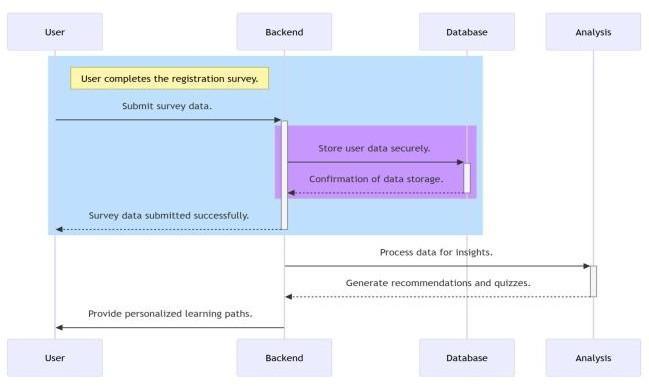
Fig-3.1.0: DataCollection
3.2 AI Algorithm for Personalized Learning Path
User Input & Data Collection: Users provide inputs like skillpreferences,quizresults,andcareerintereststhrough the frontend, which are transmitted to the backend for furtherprocessing.
Backend Processing & Decision Tree for Personalization: The backend uses a Decision Tree algorithmasthecoreoftherecommendationengine.
Feature Extraction: User inputs such as skill levels, domainchoices,andquizscoresaretreatedasfeatures.
Decision Nodes: The decision tree evaluates these featuresatmultipledecisionnodes,splittingdatabasedon
conditionslike"IstheuserskilledinPython?"or"Doesthe userscoreaboveathresholdinDataStructures?".
Path Generation: Based on the splits, the tree classifies the user into a learning segment (e.g., beginner, intermediate,advanced).
Output Recommendation: The final leaf node outputs a tailored learning path, suggesting specific courses and resourcesalignedwiththeuser’sprofile.
AI Agent for Dynamic Personalization & Feedback Loop: The AI agent functions as a continuous feedback mechanismbyinteracting withthe decision tree model. It monitors user progress and refines the learning path by re-evaluating new inputs, ensuring dynamic personalization. The refined path is sent back to the frontend, enabling a personalized and evolving learning experience.
After receiving a personalized learning path generated by the Decision Tree-based AI model, a progress tracking system will be embedded to monitor the user's journey throughout the platform. As the user engages with suggested courses, quizzes, and modules, progress data such as course completion rates, quiz scores, and time spent on tasks will be collected through the frontend (React.js) and transmitted to the backend (Spring Boot) via RESTful APIs.This data will be stored ina PostgreSQL database, directly linked to the user’s profile for continuoustracking.
The AI agent will regularly evaluate this progress data to refine the learning path dynamically. If a user shows consistent progress and high quiz scores, the model will recommend advanced resources, whereas lower performance may trigger suggestions for foundational learning content. This system ensures a personalized, adaptive learning experience while keeping users motivatedwithvisualprogressindicators,milestones,and badges, helping them stay on track toward their career goals.
The progress tracking system not only monitors user activity but also provides valuable insights into skill acquisition and content mastery. As users engage with courses, quizzes, and assessments, their progress data is continuously analyzed to assess the depth of understanding in various skill areas. Once a detailed skill profile is created, the Job Matching Algorithm leverages this data to recommend career opportunities aligned with the user’s competencies. By comparing the user's acquired skills with job role

Volume:12Issue:01|Jan2025 www.irjet.net
International Research Journal of Engineering and Technology (IRJET) e-ISSN:2395-0056 p-ISSN:2395-0072
requirements, the algorithm identifies matching positions and suggests relevant roles where the user can excel. If certain job requirements are unmet, the platform can further suggest targeted upskilling content to close skill gaps. This approach ensures a data-driven, personalized career guidance system, where job recommendations are basedonverifiedlearningprogress,maximizingbothuser employabilityandmarketalignment.
To enhance user engagement and foster an interactive learning experience, the platform integrates quizzes and gamificationelements.
Quizzes are dynamically generated from a structured databaseandtailoredtousers'careerpaths.Thesequizzes assess comprehension and provide instant feedback, reinforcinglearningoutcomes.
A point-based gamification system rewards users for completing tasks such as finishing quizzes, reaching milestones,orachievingspecificlearninggoals.Usersearn badgesforaccomplishments,whicharedisplayedontheir profilestomotivatecontinuedprogress.
Gamification is implemented through a layered architecture, where the backend (Spring Boot) tracks points, achievements, and user milestones, while the frontend (React) visualizes progress through dashboards, leaderboards, and badge collections. These elements not only encourage active participation but also provide a sense of accomplishment, creating a seamless blend of educationandmotivation.
EduWay is implemented using Spring Boot for the backend, React for the frontend, and MySQL for the database. User data collected through an interactive survey is processed with AI/ML algorithms to generate personalizedlearningpaths andcareerrecommendations. Gamification features like badges and leaderboards enhance engagement, while quizzes assess progress. The platform is hosted on AWS for scalability and provides a seamless, intuitive interface for tracking learning and careergrowth.
In modern web applications, user authentication and profile management are critical components. Java Spring Bootsimplifiesthesetaskswithitspowerfulfeatures,such as Spring Security for authentication and authorization, and Hibernate for database interaction. This section outlines how a user profile is created, login and registration are handled, and how security mechanisms functioninthebackend.
The first step in building a user management system is to design the database schema. Typically, a user table is created to store user-related information such as id, username, email, password, and additional profile details like firstName, lastName, and address. If the application requiresrole-basedaccesscontrol (RBAC),a rolestableis alsoincluded.
The relationship between users and roles is many-tomany, which is implemented via a user_roles join table. This schema allows each user to have multiple roles and eachroletobeassociatedwithmultipleusers.
User registration is facilitated through a REST API endpoint. The registration flow involves the following steps:
1. Client-Side Input: Users fill out a registration form with their details (e.g., username, email, and password).
2. Backend Validation: The backend validates the input to ensure all fields are properly formatted and no duplicateusernamesoremailsexistinthedatabase.
3. Password Hashing: The password is hashed using a securealgorithmlikeBCrypt.Thisensuresthatevenif thedatabaseiscompromised,plaintextpasswordsare notexposed.
4. Database Storage: The validated and encrypted user dataissavedtothedatabase. Fig – 4.1.0: UserRegistrationWorkflow
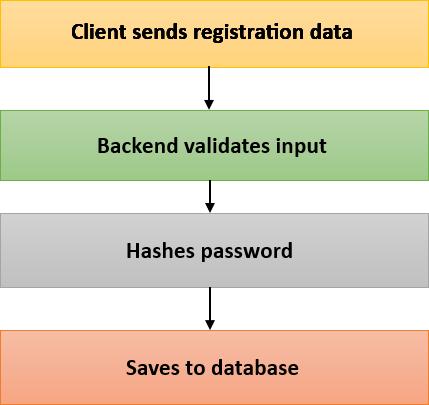

International Research Journal of Engineering and Technology (IRJET) e-ISSN:2395-0056 p-ISSN:2395-0072
Volume:12Issue:01|Jan2025 www.irjet.net
Userloginisimplementedviaanotherendpointwherethe user provides their username and password. The workflowisasfollows:
1. User Input: The client sends the credentials to the backend.
2. Credential Validation: Spring Security’s authenticationmanagerchecksthecredentialsagainst thedatabase.
3. Token Generation: If valid, a JWT is generated and returned to the client. The token is used for subsequentrequeststoprovetheuser'sidentity.
The following snippet illustrates a login process in Spring Boot:
@PostMapping("/login")
public ResponseEntity<?> authenticateUser(@RequestBody LoginDto loginDto)
{ Authentication authentication = authenticationManager.authenticate( new
UsernamePasswordAuthenticationToken(loginDto.getU sername(), loginDto.getPassword()) ); SecurityContextHolder.getContext().setAuthentication( authentication); String jwt = jwtProvider.generateToken(authentication); return ResponseEntity.ok(new JwtResponse(jwt)); }
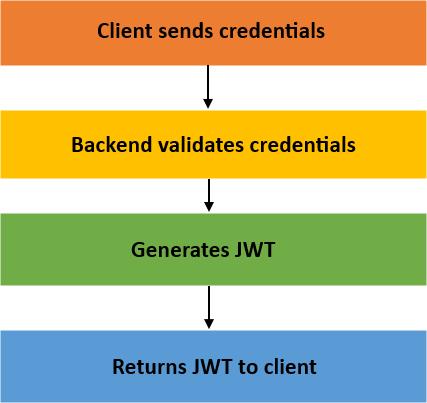
Fig – 4.1.1: UserLoginWorkflow
Once logged in, the user can access and manage their profile data. Secured endpoints fetch user details and return them in JSON format. For updates, the backend validatesthenewdatabeforesavingittothedatabase.
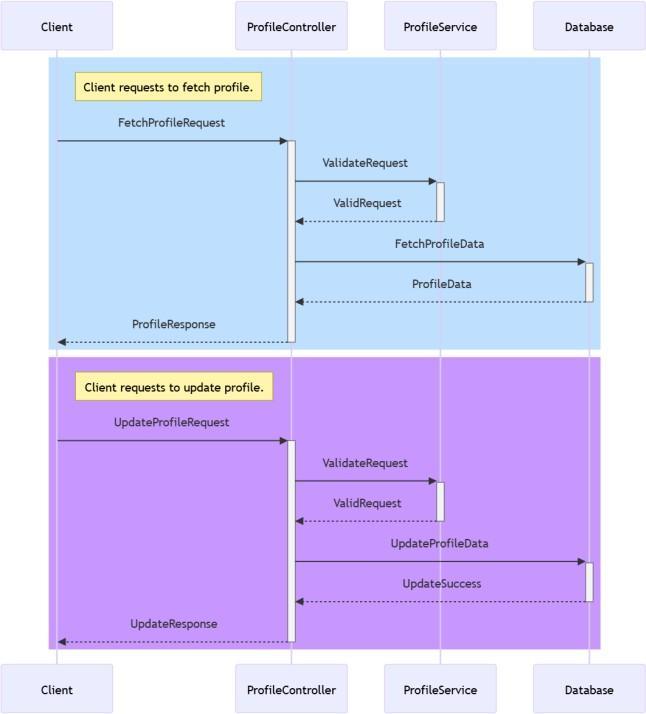
Fig – 4.1.2: ProfileManagement
Exampleendpointforfetchinguserprofile:
@GetMapping("/profile")
public ResponseEntity<?> getUserProfile(Authentication authentication){
Useruser= userService.getUserByUsername(authentication.getName ());
returnResponseEntity.ok(user); }
5.SecurityMechanism
SpringSecurityprovidesarobustsecurityframeworkwith thefollowingworkflow:
1. RequestFiltering:EveryHTTPrequestisintercepted bythesecurityfilterchain.
2. Authentication Validation: If a JWT is present, it is validated.Ifvalid,theuserisauthenticated.

Volume:12Issue:01|Jan2025 www.irjet.net
International Research Journal of Engineering and Technology (IRJET) e-ISSN:2395-0056 p-ISSN:2395-0072
3. Role-Based Access Control: Access to endpoints is determinedbytheuser’sroles.
4. ControllerHandling:Therequestisforwardedtothe appropriatecontrolleronlyifauthenticationsucceeds.

Fig – 4.1.3: SecurityWorkflow
Spring Boot allows you to configure the security filter chainusingaconfigurationclass:
@EnableWebSecurity
public class SecurityConfig extends WebSecurityConfigurerAdapter{
@Override
protected void configure(HttpSecurity http) throws Exception{
http.cors().and().csrf().disable().authorizeRequests() .antMatchers("/register", "/login").permitAll()
.anyRequest().authenticated() .and() .addFilter(new JwtAuthenticationFilter(authenticationManager()));
The platform interface is designed to provide an intuitive and engaging user experience, catering to individuals at various stages of their educational and professional journeys. The interface includes an easy-to-navigate survey section for gathering essential user information. Built with a focus on accessibility and functionality, the interface integrates seamlessly with backend services, ensuring real-time updates and personalized recommendationsforusers.
Following images shows the Interface of the platform alongwithitsinformation.
The Home Page servesasthe central hub of the platform, providing a seamless user experience and directing visitors to essential sections and features. It prominently displays the platform's purpose, offering users an engaging first impression. The page includes a "Career Explorer" button, which directs users to an interactive tooltoexplore variouscareerpaths,anda "SurveyForm" button to collect feedback and insights from users to refine the platform’s offerings. Additionally, a Sign In button enables existing users to access their profiles and resourceseasily.
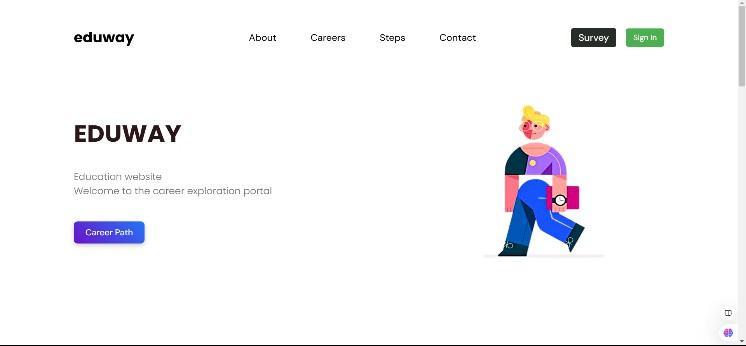
Fig – 4.2.0: Responsivehomepage
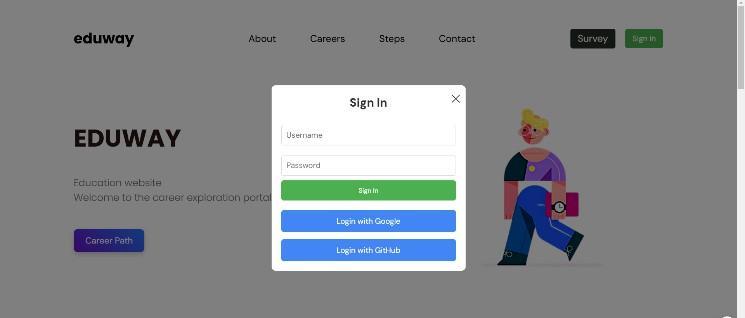
Fig-4.2.1: SignInSection

Volume:12Issue:01|Jan2025 www.irjet.net
International Research Journal of Engineering and Technology (IRJET) e-ISSN:2395-0056 p-ISSN:2395-0072
SurveyForm:
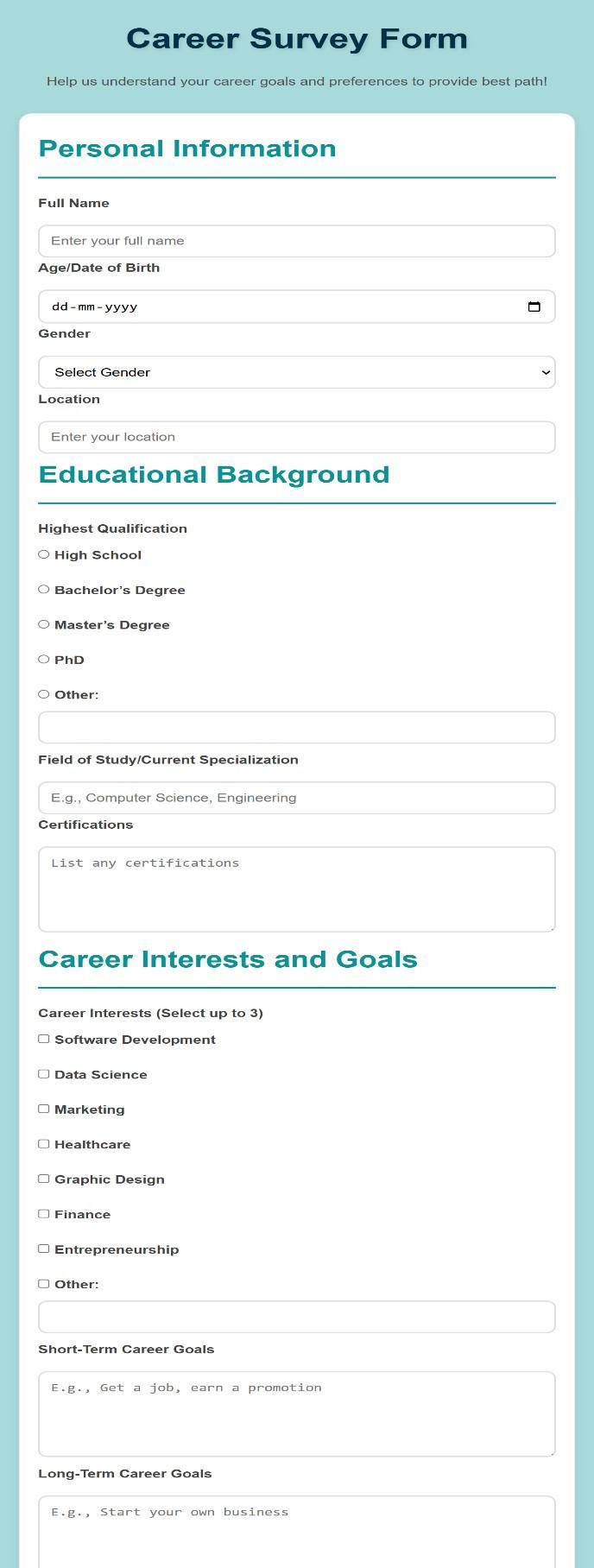
– 4.2.2: SurveyformPage
A Survey form is a structured tool used to collect data, feedback,oropinionsfromusersorrespondents.Itplaysa crucial role in understanding user preferences, improving services,orconductingresearch.
CareerPathsSection:
TheCareerPathssectionisacorefeaturethatallowsusers to explore a wide range of career opportunities. It presents information about various industries, required skills, potential growth, and salary expectations. This section is tailored to different user needs, from students choosing their first career to professionals seeking a careerchange.
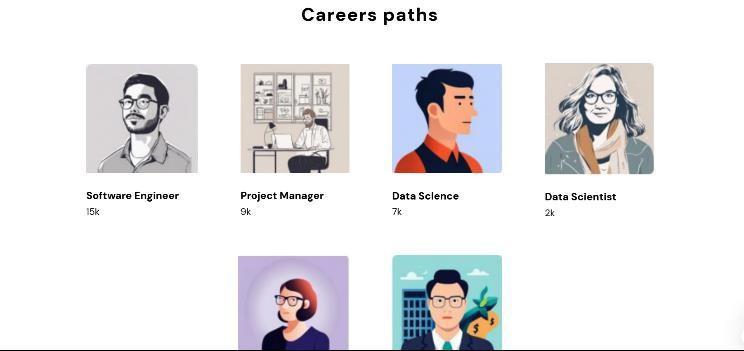
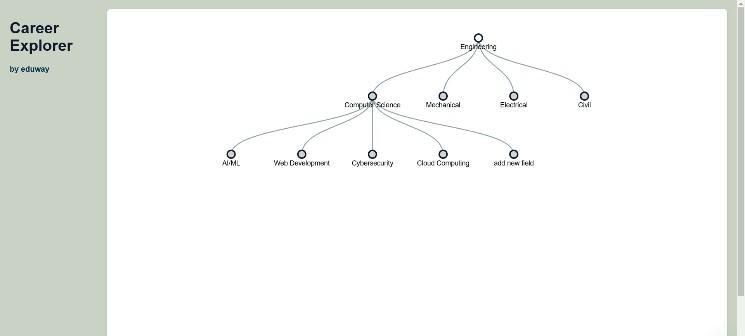
AboutUsPage:
The About section provides an overview of the platform's mission, vision, and goals. It highlights the importance of guiding students and professionals in making informed career decisions, leveraging personalized learning paths, andofferingcuratedresources.
JourneytoCareerSuccessSection:
The Journey to Career Success section outlines the stepby-stepprocessofachievingcareermilestones.Itincludes detailed explanations of goal setting, skill acquisition, networking,andleveragingresourcestobuildasuccessful career. This section is designed to motivate and educate users on the importance of a structured approach to careerdevelopment.

Volume:12Issue:01|Jan2025 www.irjet.net
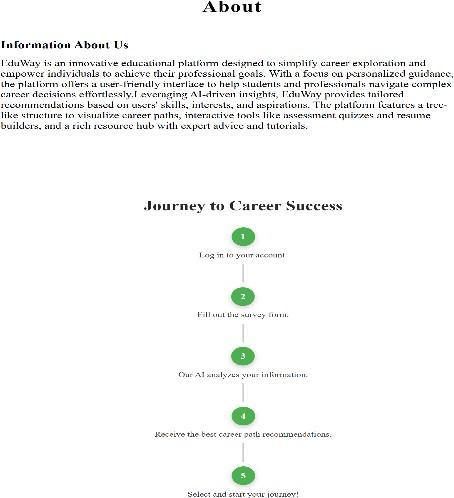
The Decision Tree Algorithm is used to generate personalized learning paths by segmenting user data based on skill levels, domain preferences, and learning history.
User data collected during registration is stored in PostgreSQLandretrievedbythebackend(SpringBoot).
The AI engine (Flask microservice) applies the Decision Tree model to classify users into skill tiers and recommendappropriatecourses.
Real-timeadjustmentsaremadeasuserprogressandquiz performance are recorded, refining the learning path dynamically. Empowers users by providingatailoredlearning experiencethatevolveswith theirgrowth.
Motivates continuous learning with personalized milestones and achievable goals. The AI engine is deployed using Docker containers managedonAWSEC2,ensuringscalabilityandflexibility.
The entire model is accessible via secure RESTful APIs integratedwiththebackendforseamlessinteractionwith thefrontend.

TheJobMarketplaceIntegrationmoduleconnectsusersto relevant job opportunities based on their skill profiles generated through progress tracking and learning outcomes. The platform uses a Job Matching Algorithm to compare the user's acquired skills, certifications, and performancedatawithjobrolerequirementsfromvarious integrated job portals and company APIs. The backend (Spring Boot) processes user data and queries external databases to fetch job listings aligned with the user’s current skill set. If skill gaps are identified, the system proactively suggests additional courses or resources from thelearningmodulestohelptheusermeetthedesiredjob criteria. This seamless data exchange ensures real-time job updates and personalized recommendations, enhancing the user’s career readiness. Additionally, the platform empowers users by presenting career suggestionsthatmatchboththeirprofessionalaspirations and learning progress, bridging the gap between education and employability. Skill profiles matched with job requirements using the Job Matching Algorithm. External job portals and company APIs integrated for personalized career options. Identifies skill gaps and suggestsadditionallearningcontent.
Toenhanceuserengagementandmotivation,ourplatform incorporatesgamificationandquizzesaskeyfeatures.
1.Badges:
The platform uses a points-based reward system, where users earn points by completing courses, quizzes, and milestones. These points contribute to unlocking badges andhigher achievementlevels,displayedonuser profiles. Badges are awarded for reaching specific milestones (e.g., completing 5 quizzes or mastering a skill). These badges

Volume:12Issue:01|Jan2025 www.irjet.net
International Research Journal of Engineering and Technology (IRJET) e-ISSN:2395-0056 p-ISSN:2395-0072
act as a visual representation of progress and accomplishment,encouragingcontinuedparticipation.
2.Quizzes:
Quizzesserveasaninteractiveassessmenttool,providing users with the opportunity to test their knowledge and reinforcelearning.Adynamicquizsystemisimplemented usingarelationaldatabasetostorequestions,options,and correct answers. Questions are tailored to the user's chosen learning path. APIs built using Spring Boot fetch questions and store results, while the front-end (developed using React) provides an intuitive and engaging quiz interface with immediate feedback on performance.
Advanced AI Models: Upgrade from a basic Decision Tree to more advanced models like Random Forest and GradientBoostingforbetteraccuracy.
Real-Time Adaptive Learning: Implement real-time data analysis to modify learning paths instantly based on quiz performance.
Integration of NLP: Use Natural Language Processing (NLP) to assess written responses and suggest personalizedresources.
ExpandedDataSources:Incorporatedatafromthird-party platforms and open educational resources for richer insights.
Gamification Elements: Introduce more engagement features like adaptive quizzes, leaderboards, and personalizedrewards.
AI as a Career Advisor: Evolve the model into a full-scale AI-driven career advisor offering dynamic career suggestionsbasedonevolvingskilldata.
Collaborative Learning Platform: Enable peer-to-peer learning by suggesting collaborative projects and group assessments.
Free Resource Integration: Link users to high-quality free educationalcontentlikeOpenCourseWareandfreecoding platforms.
Skill Certification Integration: Offer verifiable digital certificationsandbadgesrecognizedbyindustrypartners.
Continuous Learning Loop: Create a system where progressdatarefinesboththeuser’slearningpathandthe model’srecommendationsovertime.
Global Accessibility: Expand language support and accessibility features, ensuring inclusive education for a diverseaudience.
EduWay is a transformative platform that bridges education,skilldevelopment,andcareeropportunities.By using AI-powered recommendations, personalized learning paths, and gamification, it helps students, undergraduates, and professionals make informed career decisions. With a focus on skill mapping and data-driven insights, EduWay promotes continuous growth, reduces skillgaps,andsupportssustainablecareerdevelopment.
[1] Hsu, H., & Ching, Y.-H. (2013). Mobile learning design for higher education: A case study of collaborative learning and game-based learning. Journal of EducationalTechnology&Society,16(4),50-61.
[2] Chen,C.-M.,&Chung,C.-J.(2008).Personalizedmobile English vocabulary learning system based on item response theory and learning memory cycle. Computers&Education,51(2),624-645.
[3] Jiang, Z., & Benbasat, I. (2007). The effects of interactivity and vividness of functional control in virtual product experience. Information Systems Research,18(4),454-467.
[4] McKinsey & Company (2022). The skills revolution: ThefutureofworkintheageofAI.
[5] Infigon Futures. (n.d.). AI-Powered Career Counseling Platform.
[6] Helios Global. (2024, December 18). Personalized Educational Content in India: Revolutionizing Learning forEveryStudent
[7] Mindgroom. (2023, August). AI Addition to India's CareerGuidance
[8] The Impact of AI-Driven Personalized Learning on Student Achievement and Engagement in Rural vs. UrbanSchools,India.(2024).
[9] AI-Driven Career Counseling Platform. (2024). International Research Journal of Modernization in EngineeringTechnologyandScience
[10] Artificial Intelligence for Career Guidance – Current Requirements and Prospects for the Future. (2021). IAFOR Journal of Education: Technology in Education, 9(4),43-60.

Volume:12Issue:01|Jan2025 www.irjet.net
International Research Journal of Engineering and Technology (IRJET) e-ISSN:2395-0056 p-ISSN:2395-0072
[11] The Development of Artificial Intelligence in Career Initiation. (2022). European Journal of Artificial Intelligence,1(2),32-45.
[12] AI-Powered Smart and Personalized Education Platform.(2022). IEEEXplore.
BIOGRAPHIES




HarishPatil. Department of Information Technology at PCET’s Nutan Maharashtra Institute Of EngineeringandTechnology.
HrishikeshTaware. Department of Computer Engineering at PCET’s Nutan Maharashtra Institute Of EngineeringandTechnology.
PriyaBhadekar. Department of Computer Engineering at PCET’s Nutan Maharashtra Institute Of EngineeringandTechnology.
OnkarLonsane DepartmentofComputer EngineeringatPCET’sNutan MaharashtraInstituteOf EngineeringandTechnology.